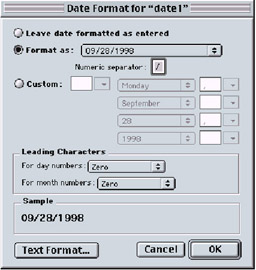
- #HOW TO EXPORT MORE THAN 256 CHARACTERS FROM FILEMAKER PRO 6 HOW TO#
- #HOW TO EXPORT MORE THAN 256 CHARACTERS FROM FILEMAKER PRO 6 PRO#
- #HOW TO EXPORT MORE THAN 256 CHARACTERS FROM FILEMAKER PRO 6 CODE#
- #HOW TO EXPORT MORE THAN 256 CHARACTERS FROM FILEMAKER PRO 6 WINDOWS#
The value is not sequential and should not be used as a key match field in relationships, but it may be used to find a unique record. The record ID is unique for each record in a single database.
#HOW TO EXPORT MORE THAN 256 CHARACTERS FROM FILEMAKER PRO 6 PRO#
FileMaker Pro automatically creates a record ID value each time a record is created, duplicated, or imported. Two attributes for the ROW element are RECORDID and MODID. The export will be correct, but element names beginning with numbers may not display properly in a browser or with other XML parsers.Įach record in the found set will be exported with the ROW element. The FileMaker Pro 6 Help topic "XML FMPDSORESULT Grammar" also recommends that you do not name your fields with a leading number. XML element names should not have any spaces. If a field name has a space, the FMPDSORESULT export will convert each space to an underscore character (_). This format more closely resembles other XML schema or grammars that you may have seen. The FMPDSORESULT grammar creates elements with the name of each field as the name of each element.
#HOW TO EXPORT MORE THAN 256 CHARACTERS FROM FILEMAKER PRO 6 CODE#
Some of the examples in this book have extra tabs and returns to make the code easier to read. This reformatted text with extra characters may not be what you want for your XML output. While it's convenient to see this structure as a "pretty-print", the XML parsers do not need to have the text reformatted.ĭo not reformat your XML exported text, as HTML editors may insert unwanted white space (spaces, tabs, and returns). The Microsoft Internet Explorer browser also has a default stylesheet that will reformat the XML with indentations. To see the tree-like structure of your data, some HTML editors will reformat the text with indentations. You may view your XML file with any text editor.

To see an example of a simple export, only select fields in the Current File.Ĭlick the Export button and a text file is created with the name you specified. Related fields and the other two options, formatting output or summarizing output, will be discussed later in this chapter. The number of records depends upon the found set prior to export, and the record order for export depends on any sort performed prior to export.Īnother option is chosen by selecting a relationship on the left to export any related fields. You may rearrange or clear fields in the Field Order list. You may, optionally, double-click a field on the left to move it to the right Field Order box. Click a field and the Move button to select a field for export.

In the Specify Field Order for Export dialog, you have several options.

The following examples show you how the XML exports and imports differ from other text exports and imports in FileMaker Pro 6. There is a slightly different dialog for specifying the XML format for export and for specifying the use of an optional stylesheet.
#HOW TO EXPORT MORE THAN 256 CHARACTERS FROM FILEMAKER PRO 6 HOW TO#
You don't need to know how to web publish to export and import XML data with FileMaker Pro 6. You can read more about the parser and processor at or through your favorite Internet search engine.Īn XML export or import is very similar to other text export or import options in FileMaker Pro. The XML plug-in uses the Xerces XML parser and the Xalan processor to import and export XML. Unlike other plug-ins, the XML plug-in does not need to be enabled, as it is always available.

#HOW TO EXPORT MORE THAN 256 CHARACTERS FROM FILEMAKER PRO 6 WINDOWS#
In FileMaker Pro 6, you can export and import using the new application programming interface (API) called, appropriately, "XML." This plug-in is located in the System folder on the Windows operating system and the FileMaker Extensions folder on the Macintosh operating system. Chapter 2: XML Import and Export with FileMaker Pro 6


 0 kommentar(er)
0 kommentar(er)
